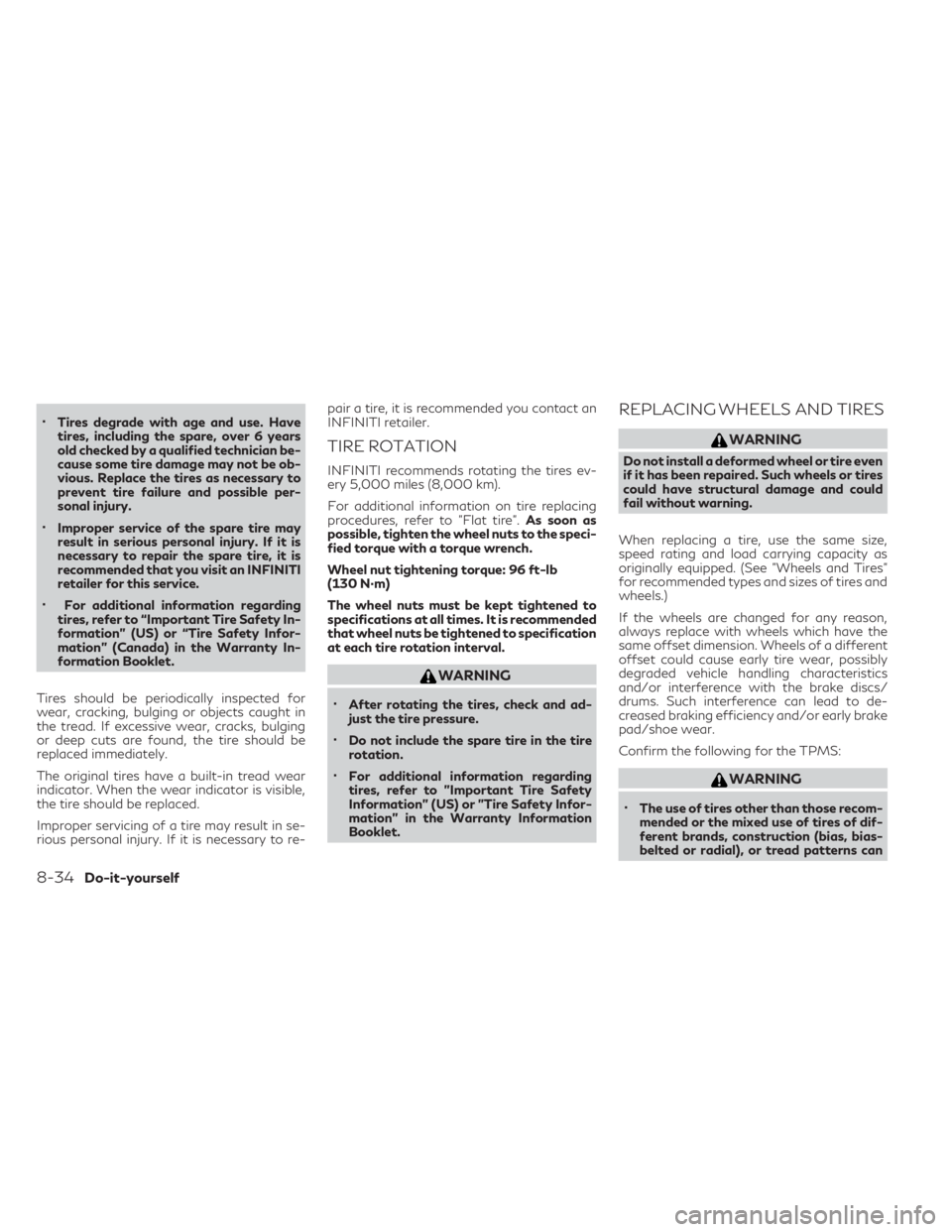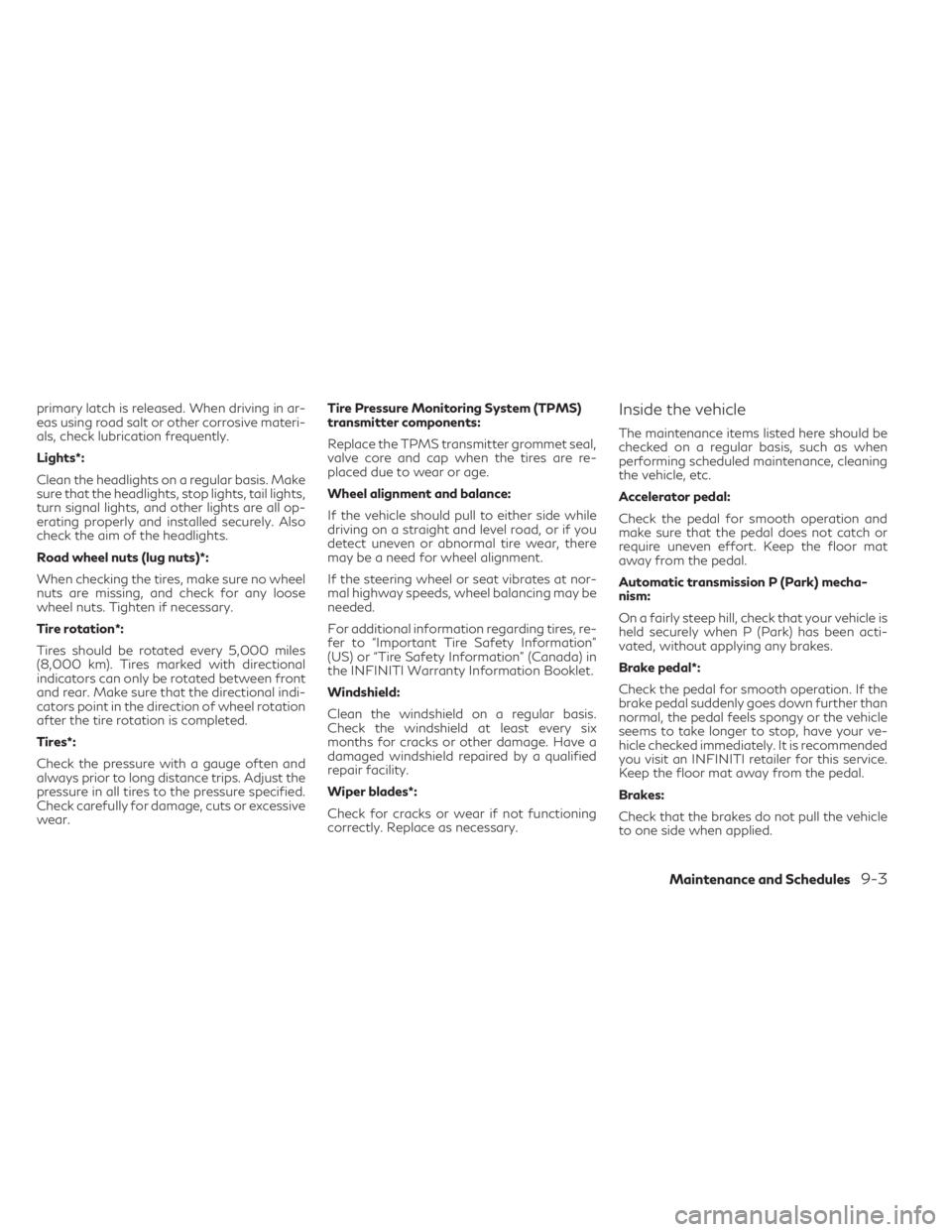service indicator INFINITI QX30 2019 Owner's Guide
[x] Cancel search | Manufacturer: INFINITI, Model Year: 2019, Model line: QX30, Model: INFINITI QX30 2019Pages: 436, PDF Size: 4.31 MB
Page 388 of 436

•Tires degrade with age and use. Have
tires, including the spare, over 6 years
old checked by a qualified technician be-
cause some tire damage may not be ob-
vious. Replace the tires as necessary to
prevent tire failure and possible per-
sonal injury.
•Improper service of the spare tire may
result in serious personal injury. If it is
necessary to repair the spare tire, it is
recommended that you visit an INFINITI
retailer for this service.
•For additional information regarding
tires, refer to “Important Tire Safety In-
formation” (US) or “Tire Safety Infor-
mation” (Canada) in the Warranty In-
formation Booklet.
Tires should be periodically inspected for
wear, cracking, bulging or objects caught in
the tread. If excessive wear, cracks, bulging
or deep cuts are found, the tire should be
replaced immediately.
The original tires have a built-in tread wear
indicator. When the wear indicator is visible,
the tire should be replaced.
Improper servicing of a tire may result in se-
rious personal injury. If it is necessary to re-pair a tire, it is recommended you contact an
INFINITI retailer.
TIRE ROTATION
INFINITI recommends rotating the tires ev-
ery 5,000 miles (8,000 km).
For additional information on tire replacing
procedures, refer to "Flat tire".As soon as
possible, tighten the wheel nuts to the speci-
fied torque with a torque wrench.
Wheel nut tightening torque: 96 ft-lb
(130 N·m)
The wheel nuts must be kept tightened to
specifications at all times. It is recommended
that wheel nuts be tightened to specification
at each tire rotation interval.
WARNING
•After rotating the tires, check and ad-
just the tire pressure.
•Do not include the spare tire in the tire
rotation.
•For additional information regarding
tires, refer to "Important Tire Safety
Information" (US) or "Tire Safety Infor-
mation" in the Warranty Information
Booklet.
REPLACING WHEELS AND TIRES
WARNING
Do not install a deformed wheel or tire even
if it has been repaired. Such wheels or tires
could have structural damage and could
fail without warning.
When replacing a tire, use the same size,
speed rating and load carrying capacity as
originally equipped. (See "Wheels and Tires"
for recommended types and sizes of tires and
wheels.)
If the wheels are changed for any reason,
always replace with wheels which have the
same offset dimension. Wheels of a different
offset could cause early tire wear, possibly
degraded vehicle handling characteristics
and/or interference with the brake discs/
drums. Such interference can lead to de-
creased braking efficiency and/or early brake
pad/shoe wear.
Confirm the following for the TPMS:
WARNING
•The use of tires other than those recom-
mended or the mixed use of tires of dif-
ferent brands, construction (bias, bias-
belted or radial), or tread patterns can
8-34Do-it-yourself
Page 393 of 436

primary latch is released. When driving in ar-
eas using road salt or other corrosive materi-
als, check lubrication frequently.
Lights*:
Clean the headlights on a regular basis. Make
sure that the headlights, stop lights, tail lights,
turn signal lights, and other lights are all op-
erating properly and installed securely. Also
check the aim of the headlights.
Road wheel nuts (lug nuts)*:
When checking the tires, make sure no wheel
nuts are missing, and check for any loose
wheel nuts. Tighten if necessary.
Tire rotation*:
Tires should be rotated every 5,000 miles
(8,000 km). Tires marked with directional
indicators can only be rotated between front
and rear. Make sure that the directional indi-
cators point in the direction of wheel rotation
after the tire rotation is completed.
Tires*:
Check the pressure with a gauge often and
always prior to long distance trips. Adjust the
pressure in all tires to the pressure specified.
Check carefully for damage, cuts or excessive
wear.Tire Pressure Monitoring System (TPMS)
transmitter components:
Replace the TPMS transmitter grommet seal,
valve core and cap when the tires are re-
placed due to wear or age.
Wheel alignment and balance:
If the vehicle should pull to either side while
driving on a straight and level road, or if you
detect uneven or abnormal tire wear, there
may be a need for wheel alignment.
If the steering wheel or seat vibrates at nor-
mal highway speeds, wheel balancing may be
needed.
For additional information regarding tires, re-
fer to “Important Tire Safety Information”
(US) or “Tire Safety Information” (Canada) in
the INFINITI Warranty Information Booklet.
Windshield:
Clean the windshield on a regular basis.
Check the windshield at least every six
months for cracks or other damage. Have a
damaged windshield repaired by a qualified
repair facility.
Wiper blades*:
Check for cracks or wear if not functioning
correctly. Replace as necessary.Inside the vehicle
The maintenance items listed here should be
checked on a regular basis, such as when
performing scheduled maintenance, cleaning
the vehicle, etc.
Accelerator pedal:
Check the pedal for smooth operation and
make sure that the pedal does not catch or
require uneven effort. Keep the floor mat
away from the pedal.
Automatic transmission P (Park) mecha-
nism:
On a fairly steep hill, check that your vehicle is
held securely when P (Park) has been acti-
vated, without applying any brakes.
Brake pedal*:
Check the pedal for smooth operation. If the
brake pedal suddenly goes down further than
normal, the pedal feels spongy or the vehicle
seems to take longer to stop, have your ve-
hicle checked immediately. It is recommended
you visit an INFINITI retailer for this service.
Keep the floor mat away from the pedal.
Brakes:
Check that the brakes do not pull the vehicle
to one side when applied.
Maintenance and Schedules9-3